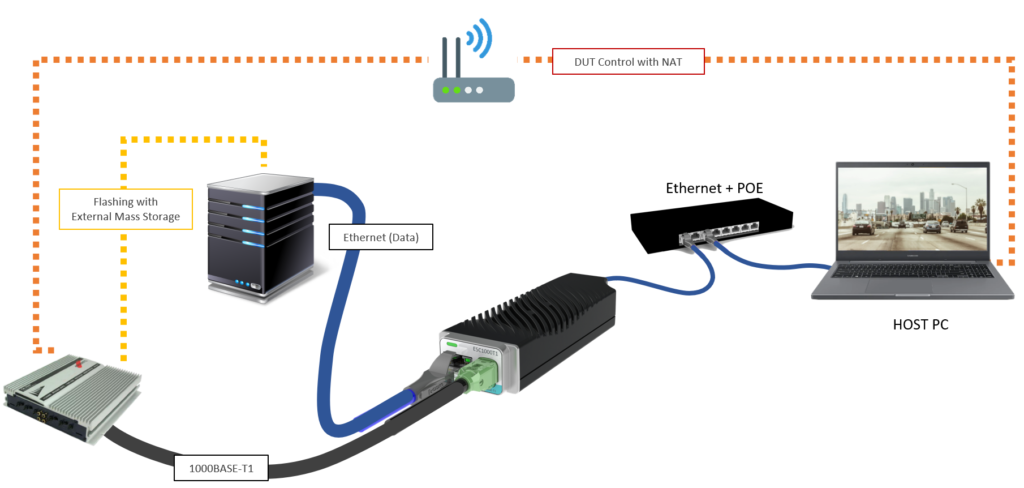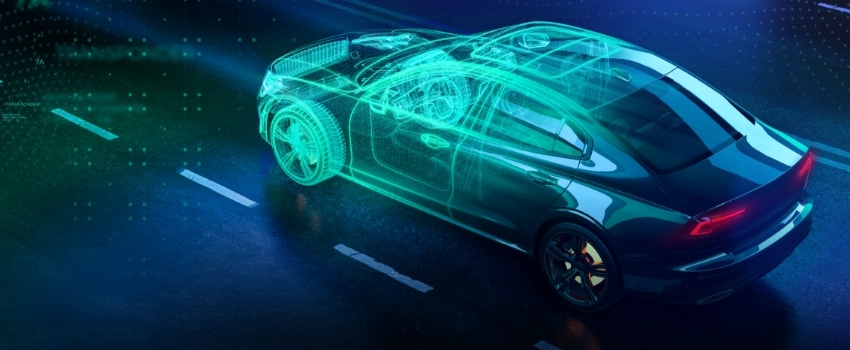Know-How: Automotive Ethernet explained: features and test needs
Tech Admin2022-08-24T12:18:46+02:00Automotive electronics in today’s vehicles are increasingly complex. With more sensors, controls, and interfaces all using higher bandwidth, faster data throughput and more reliable networks are required. The weight of the cables and harnesses in the vehicle is also of concern to manufacturers.
Ethernet has already proven to be a secure transfer medium that can handle large amounts of data and reduce weight by 30% over the traditional CAN/LIN harnesses. The advantages of Ethernet – multi-point connections, higher bandwidth, and low latency – are attractive to automotive manufacturers. However, traditional Ethernet is too noisy and interference-sensitive to be used in automobiles.
Automotive Ethernet is a physical layer standard designed for use in automotive connectivity applications. IEEE standardized the technology with 802.3bw (100BASE-T1), later expanded to 802.3bp (1000BASE-T1). The transport layers are defined by AVNU and TSN Consortiums as well as Open Alliance Consortium. In the near future autonomous vehicles will require higher bandwidths, hence Automotive Ethernet is expected to grow to hundreds of Gigabit per second , e.g. 100Gb/s, 400Gb/s, etc.
The Automotive Ethernet cable is a single unshielded copper twisted pair making it low-weight and low-cost to manufacture. The single twisted pair is a fundamental difference between standard Ethernet and Automotive Ethernet. Unlike standard Ethernet, with a dedicated transmit-and-receive path, Automotive Ethernet, has a single twisted pair being used for both transmit and receive operations at the same time. This implies that both ends of the link employ a hybrid transceiver that is capable to distinguish what it is sent from what it is received. Automotive Ethernet has a shorter cable length due to the harsh environment of the vehicle. Impedance tolerances and loss are a big deal in the vehicle environment, and they are controlled very tightly. As for the connector, RJ45 is the classic, standard interface for home and office Ethernet. The connector type for Automotive Ethernet is not defined – meaning that you are free to use whatever connector you prefer. This can be an issue in form fitting standard test requirements and does require some custom cabling and fixtures.
Testing of Automotive Ethernet Devices
In automotive applications Advanced Driver Assistance Systems (ADAS) and autonomous vehicles (AV) use lots of sensors, controls and interfaces with higher bandwidth requirements. Automotive Ethernet provides a single universal medium for communication that allows different components to coexist on the same switched network. Whenever a Device Under Test (DUT) is equipped with Automotive Ethernet, PC control of the DUT requires a Media Converter that “translates” Ethernet to BASE-T1 protocol, i.e. standard Ethernet to Automotive Ethernet.

The best test tool to solve this need is a modular solution, that can be used in R&D, V&V and manufacturing test, with a rugged and at the same time compact shape to save manufacturing floor space, closer to DUT for more efficient cabling and conceived for continuous 24/7 operations.
Flexmedia XM EMC1000T1 module is an Ethernet to 1000BASE-T1 Media Converter module. It establishes conversion between automotive ECUs using 1000BASE-T1 (1000 Mbit/s full-duplex, with single twisted pair cable) and any standard Gigabit Ethernet device with an RJ-45 connector. In this conversion, no packets are stored nor modified. The conversion takes place on the Physical Layer with the highest proven reliability. The connector for Gigabit Ethernet is a standard RJ-45, while for BASE-T1 a Rosemberger H-MTD® connector is used. The user can easily configure IEEE 100/1000BASE-T1 modes.
Flexmedia XM ESC1000T1 is an Ethernet to 1000BASE-T1 Smart Media Converter module. It integrates a versatile micro-PC based on an ARM multicore processor supporting Linux OS. The ESC1000T1 Smart Media Converter module performs as NAT, DHCP client and DHCP server. The ESC1000T1 module has preinstalled scripts to configure the basic features; furthermore, it is also possible to download new scripts for features updates.


Its typical use case is communicating with multiple DUTs with the same IP address, e.g. flashing operations.
Like all Flexmedia XM modules, they share the same rugged industrial design in a portable, palm-sized form factor. They use a Gigabit PoE low-cost control & power infrastructure, with 10/100/1000BASE-T Ethernet support, and are provided with a variety of software interfacing methods, including Windows APIs (C#/C++ SDK) and a simple OS-agnostic Command Line Interface (CLI). Remote firmware updates can be performed via Ethernet.
Conclusion
Automotive Ethernet offers a viable and unifying technology to replace previous automotive networking standards and deliver the bandwidth needed for technology-laden vehicles. Not only it provides the throughput needed today, but also offers future potential to allow the inclusion of higher resolution cameras and vehicle-to-vehicle communications. In 2020, the IEEE produced 802.3ch, which provides for multi Gigabit Ethernet at standard rates of 2.5Gbit/s, 5Gbit/s and 10Gbit/s over a maximum cable lenght of 15 meters. Shielded twisted pair wires will operate at these speeds, but electrical frequencies beyond 7 GHz may require the use of shielded parallel pair wires to minimize EMI issues. This standard will provide enough bandwidth for the next two or three platform generations.
References:
– Wikipedia: Ethernet over twisted pair

